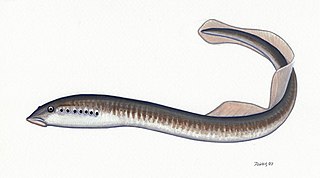
The sea lamprey is a parasitic lamprey native to the Northern Hemisphere. It is sometimes referred to as the "vampire fish".

The brook lamprey, also known as the European brook lamprey and the western brook lamprey is a small European lamprey species that exclusively inhabits freshwater environments. The species is related to, but distinct from, the North American western brook lamprey.

The Arctic lamprey, also known as the Japanese river lamprey or Japanese lampern, is a species of lamprey, a jawless fish in the order Petromyzontiformes. It inhabits coastal freshwater habitat types in the Arctic. Some populations are anadromous, spending part of their lives in the ocean. It is the most common and widespread lamprey in the Arctic region.

Geotria is the only genus in the lamprey family Geotriidae. It has 2 known species: Geotria australis and Geotria macrostoma. Both species were considered conspecific until G. macrostoma was revived in a 2020 study.

The European river lamprey, also known as the river lamprey or lampern, is a species of freshwater lamprey.

The Western brook lamprey is a small (<18 cm), widely distributed, non-parasitic species of jawless fish endemic to the freshwater coastal waterways of the Western United States and Canada. Its range extends from the North American Pacific coast from Taku River, southern Alaska, Queen Charlotte Islands, to central California, including Vancouver Island, with major inland distributions in the Columbia and Sacramento-San Joaquin watersheds.
The mountain brook lamprey or Allegheny brook lamprey is a lamprey found in parts of the Mississippi river basin, New York, Pennsylvania, Ohio, and in the Cumberland River and Tennessee River. This fish is jawless with a small sucker mouth and a long, eel-like body. It is fairly small, only growing to about 8 inches (20 cm) in length.

Mordacia is a genus of lamprey, the sole genus of the family Mordaciidae, also known as the southern topeyed lampreys.
The southern brook lamprey is a lamprey found in the Southern United States including Arkansas, Louisiana, Mississippi, Alabama, and Georgia. It is a jawless fish with a sucking mouth on one end of it. It can appear to be a small eel, since it is rarely longer than one foot in length.

The northern brook lamprey is a freshwater fish in the family Petromyzontidae. It is closely related to the silver lamprey and may represent an ecotype of a single species with I. unicuspis.

Eudontomyzon is a genus of lamprey in the family Petromyzontidae. Most species are found in Eastern Europe.
The Kern brook lamprey is a species of lamprey in the Petromyzontidae family endemic to the United States. It is found on the east side of San Joaquin Valley, in lower Merced, Kaweah, Kings, and San Joaquin rivers in California. It can grow to up to around 14 centimeters, and is characterized by its grayish brown and white coloring, and black spots on its fins.
The Miller Lake lamprey is a species of lamprey in the Petromyzontidae family endemic to the United States. Its natural habitat is the Miller Lake drainage in the state of Oregon.

Lethenteron is a genus of lamprey in the family Petromyzontidae.

Lampreys are an ancient lineage of jawless fish of the order Petromyzontiformes. The adult lamprey are characterized by a toothed, funnel-like sucking mouth. The common name "lamprey" is probably derived from Latin lampetra, which may mean "stone licker", though the etymology is uncertain. Lamprey is sometimes seen for the plural form.
Caspiomyzon is a genus of lamprey in the family Petromyzontidae. They are native to Eastern Europe and parts of Western and Central Asia. Two of the three species in the genus are endemic to Greece.
The least brook lamprey is a common, non-parasitic lamprey distributed in the Mississippi River watershed, and a limited range along the Atlantic coast.

Ichthyomyzon is a genus of lampreys in the family Petromyzontidae, native to North America.
Entosphenus is a genus of lampreys.

Lampetra ayresii is a species of lamprey in the family Petromyzontidae. It is also called the river lamprey or western river lamprey. It is found in the eastern Pacific, specifically from Tee Harbor, Juneau in Alaska to the Sacramento–San Joaquin drainage in California, USA. It can survive in both marine surface waters and freshwater lakes, rivers, and creeks. In freshwater, it is found typically in the lower portions of large river systems. It is a predatory fish and feeds on fishes in the size range of 10–30 cm. It feeds by attaching to prey using its round, sucker-like mouth. Adult western river lampreys typically grow to about 21 cm (8.3 in) total length (TL), but can reach 31 cm (12 in) TL.










